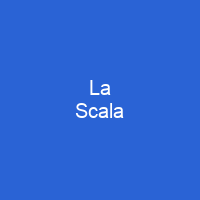La Scala is an opera house in Milan, Italy. The theatre was inaugurated on 3 August 1778 and was originally known as the Nuovo Regio Ducale Teatro alla Scala. Most of Italy’s greatest operatic artists, and many of the finest singers from around the world have appeared at La Scala.
About La Scala in brief

The opera season opens on 7 December, Saint Ambrose’s Day, the feast day of Milan’s patron saint. All performances must end before midnight, and long operas start earlier in the evening when necessary. In the tradition of the times, the main floor had no chairs and spectators watched the shows standing up. In 1883, oil lamps were replaced by gas lamps, these in turn replaced by electric lights in 1883. The original structure was renovated in 1907, when it was given its current layout with 1,987 seats. In 2006, tenor Roberto Alagna left the stage after being booed during a performance of Aida, forcing his understudy, Antonello Palombi, to quickly replace him mid-scene without time to change into a costume. For their failures, artists receive a ‘baptism of fire’ from opera aficionados, and fiascos are long remembered.
You want to know more about La Scala?
This page is based on the article La Scala published in Wikipedia (as of Dec. 27, 2020) and was automatically summarized using artificial intelligence.







